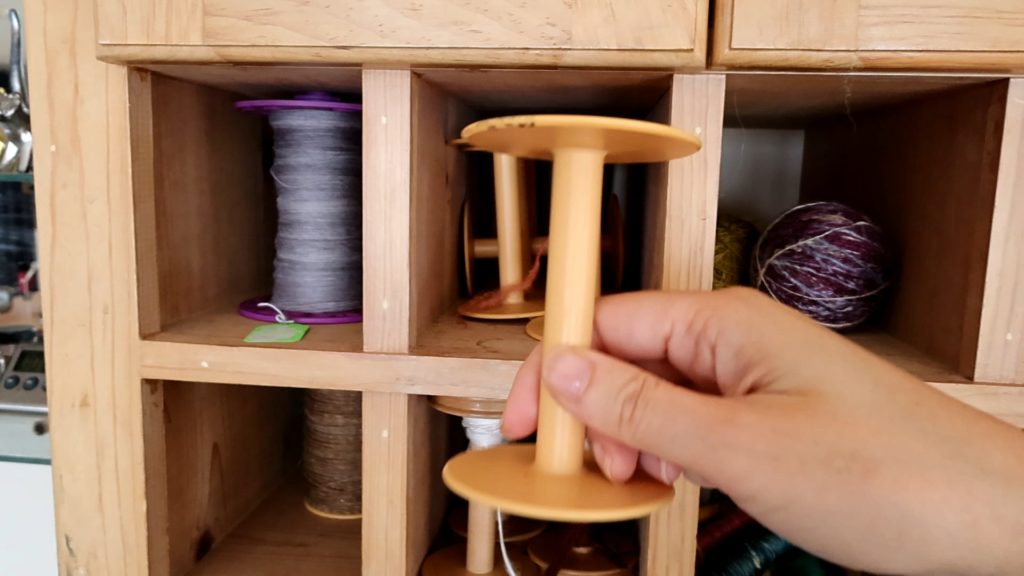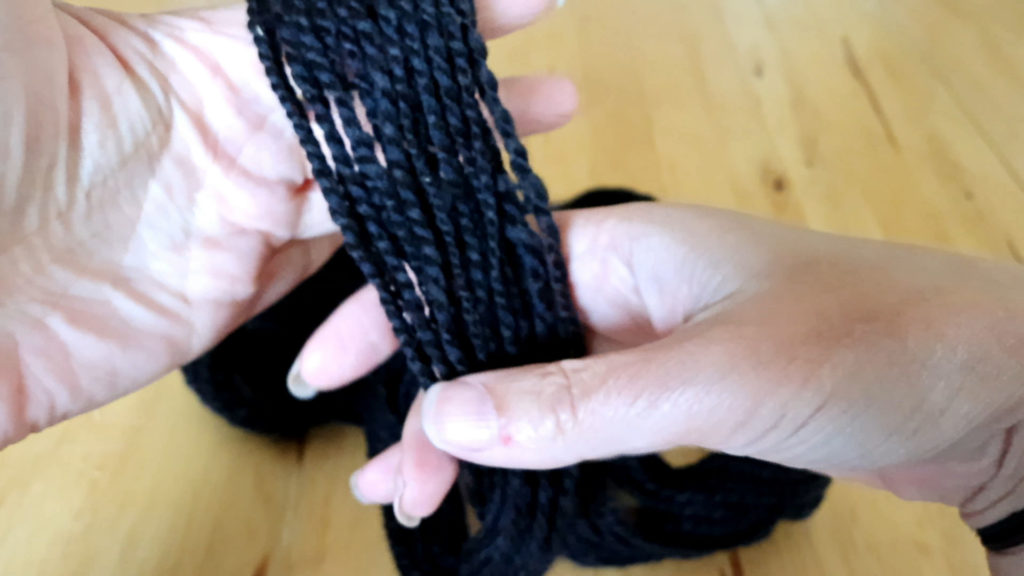I’ve been plying yarn with a spinning wheel for 12+ years, and have mixed and matched fiber types before. But I was curious: What happens when you mix 10+ year old alpaca singles with a (fairly) newly spun Merino singles? Will I actually achieve a balanced yarn or just a hot mess?
A Small Plying Experiment
I consider plying yarn not just a skill but an art form, so I’ve played around with different forms of plying many times in the past. Plying a balanced yarn, or chain plying yarn is up there among the techniques that spinners want to master. Have you ever wondered what happens if you mix two different fibers in the same yarn? I don’t mean blending before spinning, I mean one singles is one kind of fiber, plied to another singles of another type of fiber.
This past winter, I decided to spin this little skein of yarn to see what would happen. I have several storage bobbins with leftovers from past spinning projects. The leftover alpaca was a gorgeous natural black color that I obtained from the New Hampshire Sheep & Wool Festival circa 2013 (!!) and spun in 2013-2014. Yep, it’s a 10-year-old singles! Talk about resting!
As the color was a near-perfect match to some dyed Merino top that I had spun recently, I decided to ply them together to see the end result.
Unsurprisingly, it was a whirly, curly mess when I took it off the niddy noddy! But I had faith. It was nothing water, and a good thwack wouldn’t fix. The outcome was gorgeous, and I wish I had more.
What is a Storage Bobbin?

Storage bobbins are empty spools that store rewound singles after spinning. It helps even out the twist and gives them a place to rest before plying yarn. It is NOT advisable to leave your singles resting on bobbins for extended periods of time, especially not ten years! The longer your singles rest on the bobbin, the more relaxed the twist is, only to have that twist spring to life once wet. If you don’t consider this, you probably will not like the end result of your yarn.
It’s also important to wet set your yarn once spun. Imagine knitting with yarn made with well-rested singles and washing it for the first time. You’ll probably be dealing with quite a bit of shrinkage.
Believe it or not, I add more twist when plying well-rested (i.e., practically dead!) singles. Then, a wetting and thwack help redistribute that twist throughout the yarn, compensating for any unevenness.
Disclaimer: I am a self-taught spinner, I am not a technical spinner nor has anyone taught me the “proper” techniques. I prefer to learn by trial and error, and this is the method that works for me. Someone else will most likely tell you differently. I spin for enjoyment and find my own way in my craft. Now, with that out of the way…
Do I need Storage Bobbins?
Not necessarily. If you are only going to do small batch spinning, the three bobbins that came with your wheel may suffice. I usually have more than one project on the go, so I need storage bobbins. Mine are LeClerc brand, and they are larger bobbins used for weaving. I got them at a now-closed fiber store here in Canada and purchased a manual bobbin winder from LeClerc directly. I also found just the right size chuck for my drill to do it battery-powered.
I used to be adamant about re-winding my singles before plying. But between the time, the extra wear and tear on my shoulder, and the fact that my singles are always well rested before I get around to plying anyway, I only wind my singles onto storage bobbins if I am doing a large project or I have leftovers. If you are doing a lot of spinning, you may want to consider investing in storage bobbins. If you are using them solely for evening out and resting your singles, I find that as your skill grows and you become a better spinner, this step is not necessary. Just let it rest for 24 hours or so, and get plying. 🙂
How will I know my Yarn Has Enough Twist?
After you’ve been plying yarn for a while, you get more of a feel for how much twist, when, and where to add more. This is not a skill that anyone can teach you. Sure, someone can give you instruction, but from my experience, plying yarn successfully is something that you must feel.
My motto is: When in doubt, add more twist, then wet and thwack. 🙂 I know this will sound intimidating if you are starting to spin and have areas severely overtwisted. You know what? Give your singles a quick run through your wheel in the opposite direction before plying, minding those heavily twisted sections. I did this many times when I started spinning.

I am so pleased with this yarn; I wish I had more of it! I love to experiment because it’s in those times that I end up with these little gems and gain knowledge. Spinning alpaca and merino separately and ply together: check! Success! I wish you could touch it through the internet. It’s a really nice, soft, bouncy yarn with a delicious twist!
If you want to read more of my posts about fiber arts topics, see this blog’s fiber arts/dyeing/spinning category. You can also access all the videos as I make them on my new YouTube channel, which will have links to the posts they were made for.
Thanks so much for checking out my little plying experiment. 🙂
Until Next time…


